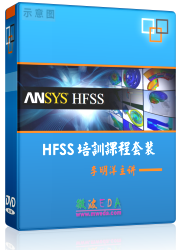HFSS Transient
HFSS Transient includes two solution types within HFSS. It employs a time-domain (“transient”) solver. Typical applications include, but are not limited to:
• Simulations with pulsed excitations, such as ultra-wide band antennas, lightning strikes, electro-static discharge;
• field visualization employing short-duration excitations;
• time-domain reflectometry.
The interface of HFSS Transient is much like the Terminal Driven solution type in the frequency domain. The geometry creation and the mesh are almost identical. Boundary conditions and definitions of ports or incident waves are almost the same, except for some restrictions in cases where certain frequency-domain options do not apply in the time domain. Therefore, you can often change an existing Terminal Driven design into a Transient design and vice versa. (Note: before doing so, you must remove the setups and solutions.)
Notable differences for transient solution types are:
• Materials cannot have arbitrary frequency dependence in a time-domain analysis. For lossy dielectrics, a Debye model is applied to ensure that the loss remain physical across the spectrum. For lossy metals, a Padé approximation is used for the same reason.
• When lossy materials touch a port, the port solver will launch an excitation that fits the lossless case. This is inherent to most time-domain solvers. The 3D part of the simulation will take losses into account correctly.
• The Analysis Setup for the transient solver is different from that of the frequency domain. Two types of analysis setup are offered:
a. Transient Network Analysis solution types - excitations are identical on all active ports and are simulated one at a time to facilitate the data collection. Saved fields can be visualized, and voltages and currents can be monitored. Your choice in setting the Transient solution type affects the options for the setup. If you select Transient Network Analysis the setup includes a tab for the Excitation for the simulation.
b. Transient Composite Excitation solution types - Different ports can have different excitations. All Active excitations are launched in one simulation. No S-parameters or TDR results may be available, but saved fields can be visualized, and voltages and currents can be monitored.
• Fields will only be saved on pre-selected surfaces, because saving all 3D fields for all times would take more disk space and I/O time than generally desired.
• If you change the size of the radiation boundary for a Transient simulation, you should expect to see changes in delay for far field results. This is because there are two origins of system for transient: one for space and one for time. For space, the original is defined the same way as frequency domain. For time, the original is located a point infinitely far away. This choice of this time origin is logical because if you place the origin at the original of a space system (in this case the center of air box) then there will be very very long time delay for every transient far field. So for the cases we have here, when air box is larger, the distance from the air box (or current source) is shorter to the time origin. Therefore we are expecting to see different time delays as radiation boundary size changes.
Related Topics
HFSS Transient Getting Started Guides
Adding a Solution Setup for Transient Solutions
Active and Passive Excitation in HFSS Transient
Differential Pairs in HFSS Transient Network
Transient Solution Theory
Selecting the Report Type in HFSS Transient
Procedure for Viewing Transient Radiated Fields
-

国内最全面的HFSS培训课程,包含7套视频教程和2本教材,资深专家讲解,视频操作演示,结合最新工程案例,让HFSS学习不再难...【详细介绍】





